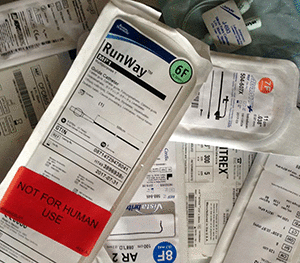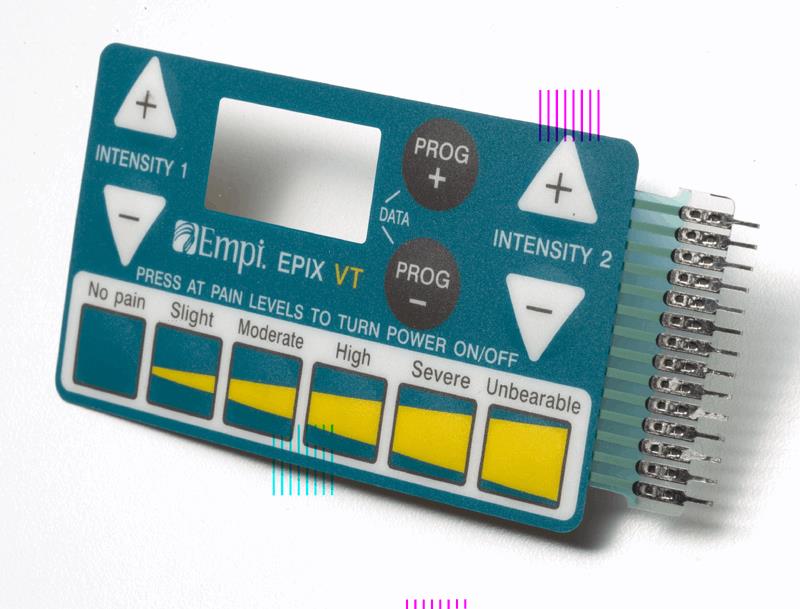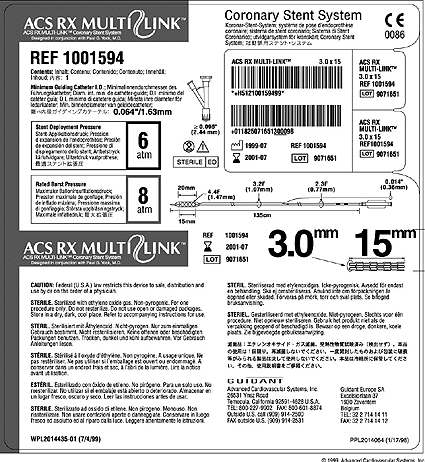7 Considerations For More Effective Medical Device Labeling And Overlays
By Brad Butterstein, Data Graphics Inc.
With all the intricacies involved in manufacturing medical devices, one of the last things that design engineers are likely to think about is the overlay, or label applied to their device. Quite simply, labels often are an afterthought, because they don’t directly affect the capabilities of the device. However, they most certainly affect the functionality of the device and users’ ability to effectively utilize all of the device’s features. Consider these factors — and their importance — as you design your medical device overlay or inventory stickers.
Branding
Your medical device labeling presents an important branding opportunity. You want your contact information to be prominent if people have questions about the device, need to order replacement parts, or want to buy new units. Clients will appreciate being able to easily access appropriate information or to quickly speak with a representative. One leading-edge solution is to embed a QR code on your label that takes people to a webpage specific to that device. The page should include FAQs and a phone number to order replacement parts or new units. You can turn your overlays and inventory labels into sales tools and technical resources, all at once.

Hierarchy Of Information
In any labeling system, it is important to use a proper hierarchy of information: The most important things should be the easiest to find, due either to the size of the printing, font, color, or the location on the label. Top center typically is the most prominent positioning, whereas the bottom corners tend to contain the least important information. If the font on any part of the signage is different — bolded, outlined, highlighted, or italicized — it stands out from the rest. Make sure that the most important things on your label stand out the most, and that the fine print stays the fine print.
Legibility And Color
Of course, the focus of an overlay is functionality, and in this case functionality means legibility. It's important to remember that sometimes medical devices will be used in darkened rooms, or congested areas, so clarity and legibility are key. This can be achieved in a few different ways.
The font you choose, the size of your printing, and contrast between copy and background all matter a great deal. Black-on-yellow and black-on-white are the strongest contrasts, with yellow-on-black and white-on-black following closely behind. Blue-on-white and vice-versa also are highly visible. To that end, we advise all medical device engineers to strategically use color in their custom overlays and labels. For variable data information, such as QR codes or barcodes, inventory stickers generally function best in black and white.
Color, however, grabs the human eye. In particular, red and yellow long have been associated with important warnings or hazards. Power switches, alert buttons, and other vital information — if set off by red or yellow — almost instinctively work to draw attention. Also, note that embossed overlays, because they are able to incorporate the sense of touch into machine operation, are much more user-friendly than flat control panels.

Expected Lifespan Of Your Overlay
Before delving into the most appropriate materials and printing methodologies, it's important to consider the demands placed on your device. Most medical devices are not expected to be subject to the same types of abuses as industrial equipment, and most medical equipment is used (and stored) in climate-controlled environments, with minimal UV exposure. Without these obvious hazards, people often underestimate the wear and tear that medical equipment endures.
Certainly, there is the wear and tear of being wheeled around medical centers, and questionable storage, but the biggest threat to overlay durability typically is cleaning chemicals. The need to clean medical devices is self-evident, and the chemicals used often degrade inks, substrates, and adhesives. It is important to consider the cleaning and sterilization procedures to which your medical device may be subjected, and then build your overlay or inventory stickers around those demands.
Devices used in the field, such as ambulance equipment or portable oxygen concentrators, may have to withstand additional wear and tear. The labels and inventory control stickers need to be just as durable. In some cases, medical devices undergo routine maintenance, and overlays or inventory stickers are replaced. In such cases, a durable, high-quality label may not be necessary. On the other hand, it often is well worth investing a little bit more to get a top-quality overlay that will last for years.
Unfortunately, there is no universal answer as to what will be the most cost-effective overlay or inventory sticker in the long term. While hot stamping and flexographically printed labels can be remarkably affordable on a cost-per-unit basis, particularly if there is a large order being placed, their inability to hold up as well may prevent their being the best long-term choice. The long service life of under-printed velvet Lexan or a metalphoto aluminum label may make them far more cost-effective in the long run. It’s vital to discuss all available options with your custom printing house. Let them present your choices, complete with a comprehensive list of pros and cons for each, and then help you determine what makes the most sense, based on the use environment and projected lifespan of your medical device.
Substrate
There are many custom label materials to choose from in designing your medical device: biaxially oriented polypropylene film (BOPP), polyesters, polycarbonates, vinyls, Tyvek, papers, foils, polyimide, steel, and aluminum. For the most durable applications, the obvious choice would be anodized aluminum or metalphoto photosensitive aluminum. These asset tags and legend plates last for decades. However, they are unworkable as overlays due to their rigidity. Vinyl makes a relatively durable, easy-to-clean, and cost-effective label. The polycarbonate Lexan is a commonly recommended overlay material, as it is durable, affordable, versatile, easy to emboss, and can be printed in a variety of different ways. It's the All-Star in the overlay game. It does, however, have some limitations, particularly if the device is likely to heat up significantly. For applications involving extreme heat, a polyester, such as Mylar, is a superior choice.
The finish on your substrate matters, as well. I recommend a satin, velvet, or brushed finish. These finishes allow for clarity and strong legibility, while at the same time hiding scratches, nicks, and day-to-day wear and tear. High gloss and semi-gloss finishes can be very eye-catching when applied to the equipment, but readily show wear and tear. Most substrates come in a wide variety of colors, including clear, which can be extremely helpful for certain printing methodologies.
Printing Methodologies
Let's begin by acknowledging that not every “printing” methodology is technically printing at all. For instance, with anodized aluminum, one would typically laser etch or computer numerical control (CNC) engrave the substrate. Both processes make remarkably durable metal tags for medical devices. Even more durable than those methods, though, is metalphoto developing.
The metalphoto process actually develops a photographic image beneath an emerald-hard anodic layer of anodized aluminum, making the image virtually impervious. Of the more traditional types of printing, the four most commonly used in printing labels and overlays are screen printing, digital printing, hot stamping, and flexographic printing.
Screen printing is the methodology of choice for most overlays, and creates the most vivid, custom-matched colors. Digital printing also is extremely popular for overlays, and is the only way to get full-color printing and photo quality images. So, if your overlay is designed with high-resolution graphics or full-color pictures, digital printing definitely is the best option. Both hot stamp printing and flexographic printing are great at creating roll labels for tagging your medical equipment. They tend to be very cost-effective and easy to apply. However, there are more significant size and color limitations with these methodologies.
Additionally, there are different ways to protect the print on your label or decal. For instance, all four of these methodologies — hot stamping, flexographic, screen printing, and digital printing — can be protected with a layer of over-laminate. In traditional printing, printers apply the ink on top of the substrate, which is called over-printing. With a clear substrate, a good printer can under-print (print on the back of the substrate), so that the substrate itself forms the barrier between the ink and the elements.

Information
When considering the options for the overlay on your medical device, consider the information you are trying to convey. For instance, do you need variable data information, such as QR codes, barcodes, or serial numbers? If so, digital printing, hot stamping, laser etching, and metal photo developing likely are your best options. How fine is the fine print on your label? For the most detailed work, flexographic printing and CNC engraving are simply untenable; digital printing and metal photo printing can achieve the greatest detail. Does the label need to conform to certain standards, such as UL 969 or PGDQ2? This greatly restricts the substrates, the adhesives, the printing methodologies, and the number of qualified custom printing houses.
Find The Right Printer
Admittedly, there are a lot of considerations to weigh here, but a few stand out.
First and foremost, find someone who is widely certified. Any reputable label printing house will have a UL certification, an ISO 9001 certification, or (most likely) both. I do not recommend working with any label house that doesn't have at least one, and preferably both, of these certifications. Second, do not limit yourself geographically. Too many manufacturers choose a printer because of location, rather than capability. A world-class printer will not allow a few miles, or a little extra shipping cost, to get in the way of excellence. Third, look for a printing house that is versatile. If your custom printer does not offer at least three or four of the seven methodologies discussed in this article, they may not be able to provide you with the best deals on the best labels. They will simply try to do your project as best they can with their available tools. As the saying goes, if all you have is a hammer, every problem looks like a nail.
Finally, ask your prospective printer about their current client load. They should be able to provide you with referrals or client testimonials, and give you some idea of projects — similar to yours — they recently have completed. This is the sign of a printer that can complete your job properly and quickly. If they have limited capabilities and no backup machines, if they lack any endorsements on their websites, or they are unwilling to give you a reference, keep searching.
About The Author
 Brad Butterstein is President of Data Graphics Inc. Brad joined Data Graphics 19 years ago and has been instrumental in its growth and development into one of the most award-winning, highly certified firms in America. He has worked with a number of the nation’s top medical device manufacturers, and has extensive experience in overlay design. Brad lives in Apopka, FL with his wife and two children. He enjoys the rooting for the Buffalo Bills and participating in his sons’ soccer tournaments.
Brad Butterstein is President of Data Graphics Inc. Brad joined Data Graphics 19 years ago and has been instrumental in its growth and development into one of the most award-winning, highly certified firms in America. He has worked with a number of the nation’s top medical device manufacturers, and has extensive experience in overlay design. Brad lives in Apopka, FL with his wife and two children. He enjoys the rooting for the Buffalo Bills and participating in his sons’ soccer tournaments.
